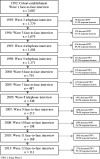Cohort Profile: The Australian Longitudinal Study of Ageing (ALSA)
- PMID: 25468824
- PMCID: PMC5841624
- DOI: 10.1093/ije/dyu196
Cohort Profile: The Australian Longitudinal Study of Ageing (ALSA)
Abstract
In response to the expressed need for more sophisticated and multidisciplinary data concerning ageing of the Australian population, the Australian Longitudinal Study of Ageing (ALSA) was established some two decades ago in Adelaide, South Australia. At Baseline in 1992, 2087 participants living in the community or in residential care (ranging in age from 65 to 103 years) were interviewed in their place of residence (1031 or 49% women), including 565 couples. By 2013, 12 Waves had been completed; both face-to-face and telephone personal interviews were conducted. Data collected included self-reports of demographic details, health, depression, morbid conditions, hospitalization, gross mobility, physical performance, activities of daily living, lifestyle activities, social resources, exercise, education and income. Objective performance data for physical and cognitive function were also collected. The ALSA data are held at the Flinders Centre for Ageing Studies, Flinders University. Procedures for data access, information on collaborations, publications and other details can be found at [http://flinders.edu.au/sabs/fcas/].
© The Author 2014; all rights reserved. Published by Oxford University Press on behalf of the International Epidemiological Association.
Figures



References
-
- Australian Bureau of Statistics. Population Projections, Australia, 2012 (Base) to 2101, catalogue no. 3222.0 .Canberra, ACT: Australian Bureau of Statistics, 2013.
-
- Andrews G, Cheok F, Carr S. The Australian Longitudinal Study of Ageing. Aust J Ageing 1989;8:31–35.
-
- Mawby L, Clark MS, Kalucy ER, Hobbin ER, Andrews GR. Determinants of formal service use in an aged population. Aust J Age 1996;15:177–81.
-
- Anstey KJ, Luszcz MA. Selective non-response to clinical assessment in the longitudinal study of ageing: Implications for estimating population levels of cognitive function and dementia. Int J Geriatr Psychiatry 2002;17:704–09. - PubMed
-
- Luszcz M, Bryan J, Kent P. Predicting episodic memory performance of very old men and women: Contributions from age, depression, activity, cognitive ability and speed. Psychol Aging 1997;12:340–51. - PubMed
Publication types
MeSH terms
Grants and funding
LinkOut - more resources
Full Text Sources
Other Literature Sources
Medical

